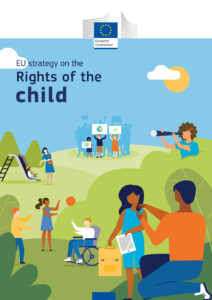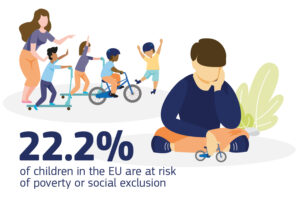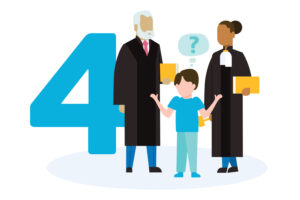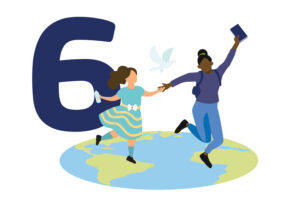It aims to bring together all new and existing EU legislative, policy and funding instruments – including ESF+ and ERDF- within one comprehensive framework to promote joint efforts to better protect all children, to help them fulfil their rights and to place them right at the centre of EU policy making.
 On 24 March the European Commission put forward its proposal for a comprehensive ‘EU Strategy on the Rights of the Child’ 2021-2024 with a view to promote joint efforts to better protect all children, to help them fulfil their rights and to place them right at the centre of EU policy making. It aims to bring together all new and existing EU legislative, policy and funding instruments – including European Social Fund Plus (ESF+) and European Regional Development Fund (ERDF)- within one comprehensive framework.
On 24 March the European Commission put forward its proposal for a comprehensive ‘EU Strategy on the Rights of the Child’ 2021-2024 with a view to promote joint efforts to better protect all children, to help them fulfil their rights and to place them right at the centre of EU policy making. It aims to bring together all new and existing EU legislative, policy and funding instruments – including European Social Fund Plus (ESF+) and European Regional Development Fund (ERDF)- within one comprehensive framework.
The Strategy is complemented by a proposal for a European Child Guarantee, which focuses on children in need (i.e. those under the age of 18 at risk of poverty or social exclusion) and makes specific reference to children with a minority racial or ethnic background (particularly Roma) as one the groups. Furthermore, the second thematic area of the Strategy puts forward measures to fight against poverty and foster equal opportunities, and to promote inclusive and non-discriminatory health and education systems. This strategy complements targeted efforts to make EU rights and values more tangible such as the Council Recommendation on Roma equality, inclusion and participation.
Why is this strategy needed?
 Despite the existing policy and financial frameworks and the efforts made over the past years at European and international level, too many children still face severe and regular violations of their rights (e.g. different forms of violence, socio-economic exclusion and discrimination); children’s concerns are not sufficiently listened to, and their views are often not considered enough in matters important to them. The COVID-19 pandemic has exacerbated existing challenges and inequalities and created new ones and has disproportionately affected vulnerable children (e.g. the shift to distance learning disproportionately affected those children living in poverty, in marginalised communities, such as Roma children).
Despite the existing policy and financial frameworks and the efforts made over the past years at European and international level, too many children still face severe and regular violations of their rights (e.g. different forms of violence, socio-economic exclusion and discrimination); children’s concerns are not sufficiently listened to, and their views are often not considered enough in matters important to them. The COVID-19 pandemic has exacerbated existing challenges and inequalities and created new ones and has disproportionately affected vulnerable children (e.g. the shift to distance learning disproportionately affected those children living in poverty, in marginalised communities, such as Roma children).
And, with differences from country to country, the situation is worse for certain groups, including Roma children, e.g. the poverty risk for children with a migrant or Roma background is up to three times higher than that of other children; early leavers from education and training still represent more than 60% among Roma youth (compared to the around 10% of young people in the EU) and only 28% have completed upper secondary education (83% among young people as a whole). Of Roma children in primary schools, 44% attend segregated primary schools, undermining their chances of succeeding in subsequent stages of education.
Two dimensions: actions across thematic areas and mainstreaming of children’s rights
I. Actions across six thematic areas
The Strategy proposes a series of targeted actions across six thematic areas, each one defining the priorities for EU action (at the European Commission and Member States’ level) in the coming years.
 1. Participation in political and democratic life at the local, national and EU levels: An EU that empowers children to be active citizens and members of democratic societies. Among other actions, the Commission proposes to establish, jointly with the European Parliament and child rights organisations, an EU Children’s Participation Platform, to connect existing child participation mechanisms at local, national and EU level, and involve children in the decision-making processes at EU level.
1. Participation in political and democratic life at the local, national and EU levels: An EU that empowers children to be active citizens and members of democratic societies. Among other actions, the Commission proposes to establish, jointly with the European Parliament and child rights organisations, an EU Children’s Participation Platform, to connect existing child participation mechanisms at local, national and EU level, and involve children in the decision-making processes at EU level.
 2. Socio-economic inclusion, health and education: An EU that fights child poverty, promotes inclusion and child-friendly societies, health and education systems. Key meaures to combat child poverty and foster equal opportunities include the establishment of a European Child Guarantee targeting specifically children at risk of poverty or social exclusion and a call for Member States to implement the reinforced Youth Guarantee and promote the involvement of young people in Youth Guarantee services.
2. Socio-economic inclusion, health and education: An EU that fights child poverty, promotes inclusion and child-friendly societies, health and education systems. Key meaures to combat child poverty and foster equal opportunities include the establishment of a European Child Guarantee targeting specifically children at risk of poverty or social exclusion and a call for Member States to implement the reinforced Youth Guarantee and promote the involvement of young people in Youth Guarantee services.
The Strategy also aims to ensure the right to healthcare for all children by for example addressing children’s mental health (e.g. mental health problems often faced by migrant children in the country of origin, on the migratory route or the country of arrival) and helping support healthy and sustainable food in EU schools and outside.
Finally, it makes proposals to guarantee an inclusive, non-segregated and quality education for all children. Key actions by the Commission include: a new initiative “Pathways to School Success” to contribute to decouple educational attainment and achievement from social, economic and cultural status; the setting up of an expert group for creating supportive learning environments for groups at risk of underachievement and supporting well-being at school; the proposal of a revision of the Barcelona targets on participation in early childhood education and care; the proposal of a Council recommendation on online and distance learning in primary and secondary education; support to Member States in implementing the 2020 Council recommendation on Vocational Education and Training for sustainable competitiveness, social fairness and resilience; and the promotion of the Toolkit for inclusion in early childhood education and care. The Commission invites Member States to work towards achieving the targets proposed within the European Education Area and to continue implementing fully, in close cooperation with the European Commission, all relevant actions recommended in the Action Plan on Integration and Inclusion 2021-2024 in the area of education and training.

3. Combating violence against children and ensuring child protection: an EU that helps children grow free from violence. The Commission will propose legislation to combat gender-based and domestic violence and table recommendations to prevent harmful practices against women and girls. Member States are invited to build integrated child protection systems and improve their functioning, to strengthen response to violence in schools and to adopt national legislation to put an end to corporal punishment in all settings.
 4.Child-friendly justice: An EU where the justice system upholds the rights and needs of children so that they feel comfortable and safe to participate effectively in the proceedings and judicial systems (as victims, witnesses, suspects, accused of having committed a crime, or party to any legal proceeding). The Commission will, for example, contribute to specialised judicial training and work with the Council of Europe to implement the 2010 Guidelines on Child Friendly Justice. Member States are invited to support training for example, and to develop robust alternatives to judicial action such as alternatives to detention or mediation in civil cases.
4.Child-friendly justice: An EU where the justice system upholds the rights and needs of children so that they feel comfortable and safe to participate effectively in the proceedings and judicial systems (as victims, witnesses, suspects, accused of having committed a crime, or party to any legal proceeding). The Commission will, for example, contribute to specialised judicial training and work with the Council of Europe to implement the 2010 Guidelines on Child Friendly Justice. Member States are invited to support training for example, and to develop robust alternatives to judicial action such as alternatives to detention or mediation in civil cases.
 5. Digital and information society: An EU where children can safely navigate the digital environment and harness its opportunities. The European Commission invites the Member States to ensure effective equal access to digital tools and high-speed Internet connection, digital literacy, accessible online educational material and education tools etc. for all children; and to support the development of children’s basic digital competences, through the Digital Competence Framework for citizens. The Commission will adopt different measures to promote the access and accessibility of ICT as well as to provide a safe online experience (e.g. adoption of an updated Better Internet for Kids Strategy).
5. Digital and information society: An EU where children can safely navigate the digital environment and harness its opportunities. The European Commission invites the Member States to ensure effective equal access to digital tools and high-speed Internet connection, digital literacy, accessible online educational material and education tools etc. for all children; and to support the development of children’s basic digital competences, through the Digital Competence Framework for citizens. The Commission will adopt different measures to promote the access and accessibility of ICT as well as to provide a safe online experience (e.g. adoption of an updated Better Internet for Kids Strategy).
 6.The Global Dimension: an EU that supports, protects and empowers children globally, including during crisis and conflict. Proposals include the allocation of 10% of humanitarian aid funding for education in emergencies and protracted crises, the drafting of a Youth Action Plan to promote youth and child participation globally, and to strengthen child protection capacities within EU Delegations.
6.The Global Dimension: an EU that supports, protects and empowers children globally, including during crisis and conflict. Proposals include the allocation of 10% of humanitarian aid funding for education in emergencies and protracted crises, the drafting of a Youth Action Plan to promote youth and child participation globally, and to strengthen child protection capacities within EU Delegations.
II. Embedding a children’s rights perspective across all relevant EU policies, legislation and funding programmes
This will be supported by measures such as the provision of training and capacity building to EU staff and enhanced internal coordination through the team of the Commission’s coordinator for the rights of the child and the elaboration of a checklist on the rights of the child. To obtain reliable and comparable data to develop evidence-based policies, the Commission will invite the EU Fundamental Rights Agency (FRA) to continue providing Member States with technical assistance and methodological support, inter alia, on the design and implementation of data collection exercises. More age and sex-disaggregation of Eurostat data, and data generated by other EU agencies, will also be pursued, as will research on specific thematic areas covered by this Strategy.
The strategy also aims to help with the mainstreaming and coordination of initiatives at national level and among key stakeholders to ensure better implementation of existing EU and international legal obligations. The Commission will establish the EU Network for Children’s Rights to reinforce the dialogue and mutual learning between the EU and Member States and support the implementation, monitoring and evaluation of the Strategy and will develop closer collaboration with regional and local authorities, and with other relevant institutions, regional and international organisations, civil society and ombudspersons for children.
Contribution of EU Funds to the Strategy
Funding for child rights should be prioritised by Member States in the EU funding programmes, according to identified needs at national and regional level. The 2021-2027 multiannual financial framework offers a wide range of possibilities for the realisation of children’s rights and the implementation of the policy objectives proposed. The ESF+ and the ERDF can support investments in human capacity and infrastructure development, equipment and access to mainstream and quality services (in education, employment, housing, social, health and child care…), as well as the shift from institutional to family- and community-based services, with particular attention to the poorest regions of the Union, where public services tend to be less developed. In addition, Member States that have a rate of child at-risk-of-poverty or social exclusion higher than the EU average (in 2017-2019) will have to earmark 5% of the ESF+ for combatting child poverty, while other Member States will be required to earmark an appropriate amount. Furthermore, in the 2021-2027 programming period, Member States should fulfil several enabling conditions, which might have a close link to child rights measures. This includes policy frameworks in the field of poverty reduction, Roma inclusion and compliance with the EU Charter of Fundamental Rights.
Other funds could also be relevant, including the Recovery and Resilience Facility, the new Asylum, Migration and Integration Fund (AMIF), the Justice Programme, the Citizens, Equality, Rights and Values (CERV) Programme, the Erasmus+, the Horizon2020, the Digital Programme, the European Agricultural Fund for Rural Development (EAFRD), REACT-EU and InvestEU. The Commission will encourage Member States to make full use of the possibilities offered by NextGenerationEU to mitigate the disproportionate impact of the crisis on the most vulnerable children and will help Member States to mainstream children’s rights in the design and implementation of reforms through the Technical Support Instrument.
Next steps
The Commission invites the European Parliament and the Council to endorse the strategy and work together on its implementation. The Commission calls on the Committee of the Regions and the European Economic and Social Committee to promote dialogue with local and regional authorities and civil society.
The Commission will monitor the implementation of the Strategy at EU and national level and report on the progress at the annual European Forum on the rights of the child. Following an inclusive approach, children will be part of the monitoring and evaluation, notably through the future Children’s Participation Platform.
The Commission calls on EU Member States to develop, where not yet available, robust and evidence-based national strategies on the rights of the child, in cooperation with all relevant stakeholders, including children; and in synergy with other relevant national strategies and plans.
Further information
- European Commission’s Communication ‘EU strategy on the rights of the child’, COM(2021) 142 final (available in all EU languages)
- Other relevant information and documents
- EUROMA news item on the proposal for a European Child Guarantee

